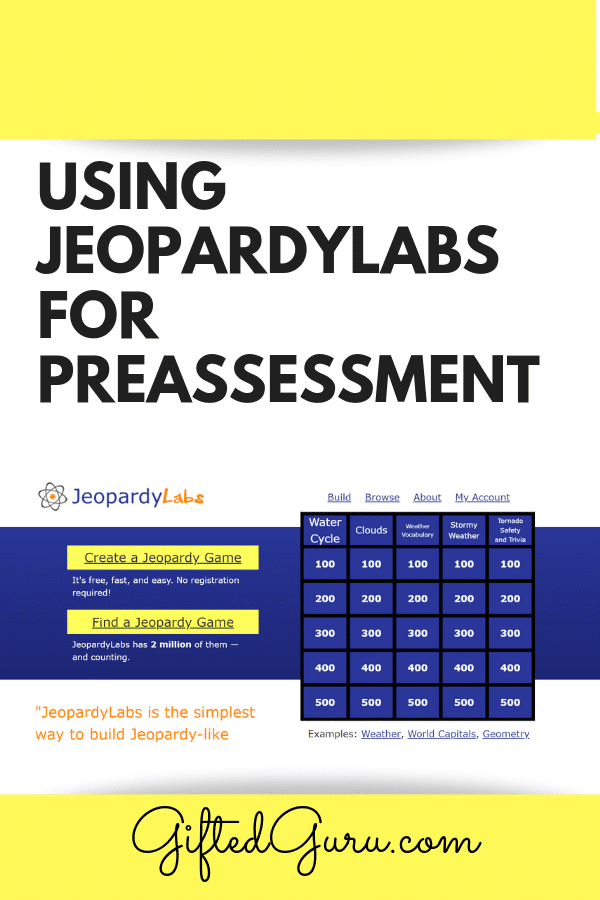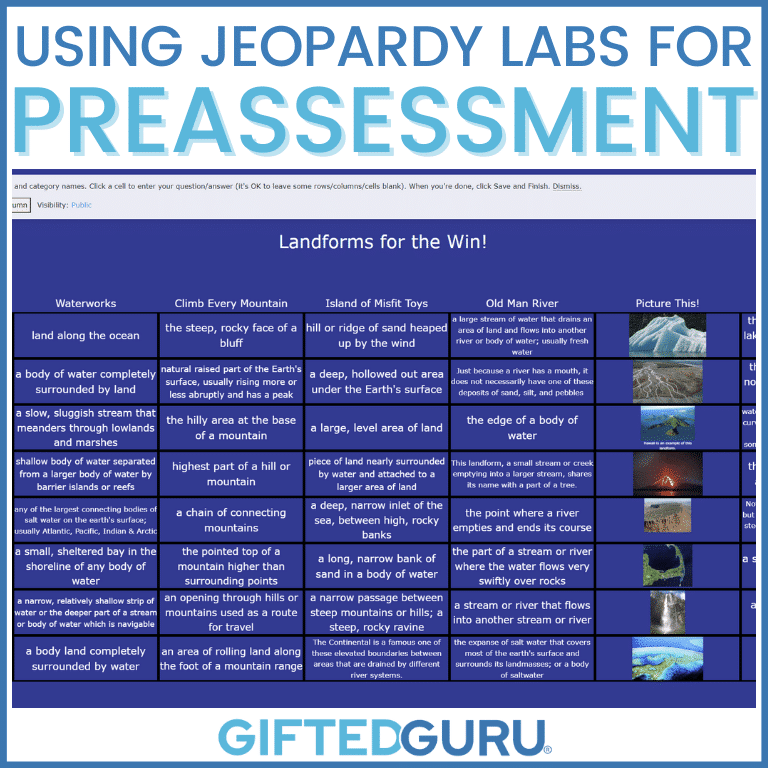In the article about creating a differentiated lesson plan step-by-step, I shared a lesson plan on landforms that used a cloud-based Jeopardy! game as a pre-assessment tool.
I thought I would share a little more about how and why I do that.
Jeopardylabs.com
First, let me introduce you to Jeopardylabs.com.
This site allows you to create online Jeopardy! games that are super easy to use and super fun to play.
It’s a freemium model, meaning that you can use many features for free, and you pay a small one-time fee to activate a lot more cool features.
Here’s a video explaining how it works:
Preassessment in General
The purpose of preassessment is to gauge the level of mastery a student has attained in order to know what they still need to learn/be able to do.
When creating any preassessment, I keep these things in mind:
- What are the fundamental elements of knowledge the student needs to have mastered? This is the knowing/understanding level.
- How will they be using the knowledge? I have to know that they can manipulate it, not just recite it.
- In what form will the learning ultimately be assessed? The preassessment needs to mirror the form of ultimate assessment. If the ultimate assessment has images to be analyzed, the preassessment must, too. If the assessment has an essay or some other format, that’s what the preassessment needs to look like. If not, your data will be off.
Sometimes preassessment excuses students from a learning experience (essentially “testing out”) and opens the door to compacted learning.
Sometimes, as in the case of the differentiated lesson I shared, it tells me as the teacher that the student has mastered the foundations and is ready to engage in higher levels of thinking with the material.
The idea that foundational knowledge and critical thinking are at odds with each other, that so-called “rote” memorizing is somehow inferior and/or unnecessary is false.
You cannot critically examine what you do not know. The idea that if a student can Google the answer the question isn’t worth asking is ludicrous. That’s not how thinking works.
We think critically about what we have learned and internalized, not what we only look up.
Using Jeopardylabs for Preassessment
Jeopardy!-style preassessment works best when you are assessing foundational knowledge. While possible, it is much more challenging to assess higher levels of thinking.
I use this style (and this site) to test mastery of foundations to be sure the students are ready to work at deeper levels.
You can create it yourself, or you can have students create it.
Here is a screencast of my landforms preassessment created with Jeopardylabs so you can see what it looks like:
Tips for Successful Jeopardylabs Experiences
- When using Jeopardylabs for preassessment, I usually have students play on their own. One of the beauties of Jeopardylabs is that it allows your class to all play the same game simultaneously, but not together.
- If I’m doing a less formal preassessment, I may play as a class or divide the students into teams to play in small groups.
- I try to make sure that the questions are not at all confusing. If the question can be misinterpreted easily, I can’t get good data about the students’ knowledge.
- I create the categories ahead of time, dividing the information into groups and then balancing it out. I find that sketching this out on paper first saves me a lot of time when creating the game.
- I am more interested in the number correct than I am in the actual points, so I have students use tally marks to track how many they got correct while the game tracks their points.
- I will sometimes use the same game for a review later, so then it’s really time effective.
- If you (or, more likely, your students) find a question/answer that’s wrong or confusing, you can simply fix it. Please do it right away or you will forget (#cautionarytale).
How Much Time Does This Take?
Creating the board takes varying amounts of time depending upon:
- How clear you are about what you want to ask. If you’re still thinking of the types of questions, it takes longer.
- One of the beauties of Jeopardylabs is that you can search for and use boards created by others. If you find one that works, obviously you’re set. You may find that no one board works perfectly, but you can canibalize a few of them.
- When creating a board from scratch, I usually expect to spend 45 minutes, depending upon the complexity, the number of questions, if I have images I need to find, etc.
- The time it takes to play depends upon the type of question (if they’re solving equations, that takes longer than recall, for example), the number of questions, and if they’re playing alone (faster) or in a group (slower).
How Much Does it Cost?
Jeopardylabs operates on a freemium model, meaning that you can use it for free, but some features are only available with a paid account.
At the time of this writing, it’s $20 one time for the rest of your life, so that’s pretty affordable.
With the paid version, you can:
- Insert/upload images
- Insert math equations
- Embed videos/audio files from YouTube, Vimeo, Soundcloud, etc.
- Add more questions to your game (additional rows and columns)
- Easily manage all your JeopardyLabs templates from one place
- Make your games private
- Keep all of your games on a single webpage you have a link directly to
I’d suggest using the free version until you get to the point where you know that you want to keep using it AND there is something you want to do that you can’t do for free.
For example, when I’m working with visual material (maps, shapes, etc.), I need the ability to upload images.
Wrapping Up
Jeopardylabs is a terrific tool that can be used (for free!) for preassessment.
Because it’s a game, students don’t feel intimidated. Because they can play by themselves, they don’t get embarrassed if they get a question wrong.
This is one tool in my toolbox that I hope some of you can use as well!
You May Also Like:
- A Differentiated Lesson Plan Step-by-Step
- CONTIG: Free Math Game Download
- Lectio Verum: A New Twist on an Ancient Technique for Reading in the Classroom
If you’re not already getting the newsletter every month, please consider signing up. When you do, you’ll receive my free guide on how to help gifted kids thrive in school in addition to all the email goodness!





